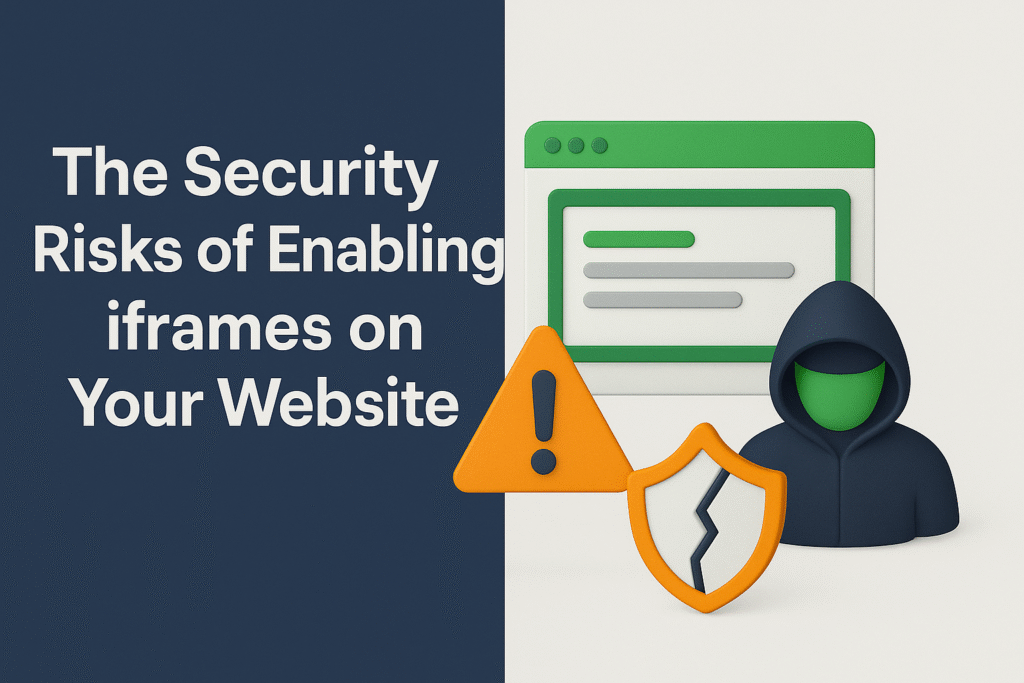Introduction
Iframes (Inline Frames) are a powerful HTML feature that allows developers to embed external content, such as videos, maps, advertisements, or third-party widgets, seamlessly within a webpage. While iframes provide convenience, they also introduce significant security risks that can compromise both your website and its users.
As a web developer, understanding these risks is crucial before implementing iframes on your site. This blog post will explore:
- What iframes are and how they work
- Major security risks associated with iframes
- Real-world attack scenarios
- Best practices to mitigate risks
By the end, you’ll have a clear understanding of how to use iframes safely—or avoid them when necessary.
What Are iframes and How Do They Work?
An iframe (<iframe>) is an HTML element that embeds another HTML document inside the current page. Common use cases include:
- Embedding YouTube videos
- Displaying Google Maps
- Loading third-party widgets (e.g., social media buttons, payment forms)
- Integrating external ads
Basic html iframe
<iframe src="https://mywebsite.com" width="600" height="400"></iframe>
While this seems harmless, improper use of iframes can lead to severe security vulnerabilities.
Security Risks of Using iframes
1. Clickjacking Attacks, What is Clickjacking?
Clickjacking is a technique where attackers trick users into clicking hidden or disguised elements by overlaying an invisible iframe on top of a legitimate webpage.
How It Works:
- A malicious site loads your webpage inside a transparent iframe.
- The attacker positions invisible buttons (e.g., “Like,” “Buy,” “Transfer Money”) over harmless-looking elements.
- When users click what they believe is a safe button, they unknowingly interact with the hidden iframe.
Real-World Example:
- A fake “game” website overlays a banking site’s “Transfer Money” button.
- Users think they’re clicking “Play,” but they’re actually sending money to the attacker.
Impact:
- Unauthorized transactions
- Data theft
- Compromised user trust
2.UI Redressing (Malicious Widget Injection)
What is UI Redressing?
UI Redressing is an advanced form of clickjacking where an attacker doesn’t just overlay hidden elements, they completely hijack and modify embedded UI components (like chat widgets, login forms, or ads) to deceive users into performing unintended actions.
Unlike traditional clickjacking (which tricks users into clicking invisible buttons), UI redressing actively replaces or manipulates legitimate iframe content to create fake interfaces that look authentic.
How UI Redressing Works
- The Attacker Embeds Your Widget in a Malicious Site
- Example: Your customer support chat widget is embedded via iframe on a scam website.
- The attacker then modifies the CSS/JavaScript to make it appear as part of their fake login portal.
- Users Interact with a Fake Version of Your UI
- A victim sees what looks like your official chat widget but is actually a phishing tool.
- When they type a message, it sends credentials or payment info to the attacker.
- Unauthorized App Creation
- Since your iframe is active and embeddable, attackers can use it to create fake applications (Windows, iOS, or Android) that appear to be your official software.
- They repackage your iframe inside their malicious app and add hidden functions (keyloggers, credential stealers, or ransomware).
- Users download what looks like your legitimate app, but it secretly performs harmful actions in the background.
3. Cross-Site Scripting (XSS) via iframe Injection
What is XSS?
XSS occurs when an attacker injects malicious scripts into a webpage, which then execute in the user’s browser.
How iframes Enable XSS:
- If your site allows user-generated content (e.g., comments, forums), an attacker could inject a malicious iframe.
- A compromised third-party script could load harmful iframes without your knowledgeIf this executes, it could:
- Steal cookies/session tokens
- Redirect users to phishing sites
- Install malware
Impact:
- Account hijacking
- Malware distribution
- SEO blacklisting
4. Phishing & Spoofing Attacks
How Attackers Exploit iframes for Phishing:
- A fake login form is loaded in an iframe, mimicking a legitimate site (e.g., Facebook, PayPal).
- Users enter credentials, which are sent directly to the attacker.
Impact:
- Credential theft
- Financial fraud
- Reputation damage
5. SEO & Performance Issues
SEO Problems:
- Search engines may struggle to index iframed content properly.
- Overuse of iframes can lead to lower rankings.
Performance Issues:
- Each iframe adds an extra HTTP request, slowing page load times.
- Heavy third-party iframes (e.g., ads) can significantly degrade performance.
Best Practices to Secure iframes on Your Website.
1. Disable iframes Entirely When Not Needed
The most secure approach is to completely prevent iframe embedding of your site when it serves no business purpose. This eliminates all iframe-related attack vectors.
Why this matters:
- Eliminates clickjacking risks
- Prevents UI redressing attacks
- Removes potential XSS vectors
- Simplifies your security posture
When to use:
- If your site never needs to be framed
- When no legitimate widgets or embeds are required
- For maximum security with minimal functionality impact
2. Restrict to Same-Origin Only for Internal Use
When iframes are necessary for internal functionality but not external embedding, enforce strict same-origin policies.
Key protections:
- Only allows framing by your own domain
- Blocks all external sites from embedding your content
- Maintains internal functionality while preventing external abuse
Use cases:
- Internal admin portals
- Dashboard components
- Application UI elements that require framing
- Any legitimate same-origin framing needs
3. Additional Security Measures for Required iframes
For cases where external embedding is necessary, implement these layered defenses:
Strict Sandboxing
<iframe sandbox="allow-scripts allow-same-origin" src="..."></iframe>
Content Security Policy
Content-Security-Policy: frame-src https://trusted-domain.com
Security Headers Combination
X-Frame-Options: ALLOW-FROM https://trusted-partner.com Content-Security-Policy: frame-ancestors https://trusted-partner.com
Regular Security Audits
- Monitor for unexpected iframe usage
- Verify third-party sources regularly
- Test for clickjacking vulnerabilities
Iframes can be powerful tools, but their misuse can lead to devastating security breaches, clickjacking, UI redressing, XSS attacks, and more. Protecting your website requires more than just basic safeguards; it demands expert implementation, continuous monitoring, and proactive security measures.
Why Choose Us?
At WP Webgreen, we specialize in:
✅ Secure Web Development – Building websites, apps, software with security-first principles to prevent vulnerabilities like unsafe iframe usage.
✅ Penetration Testing & Security Audits – Identifying and fixing risks before attackers exploit them.
✅ Custom Security Solutions – Tailored protections for your specific needs, from CSP policies to advanced sandboxing
Contact us today for a free security consultation.




